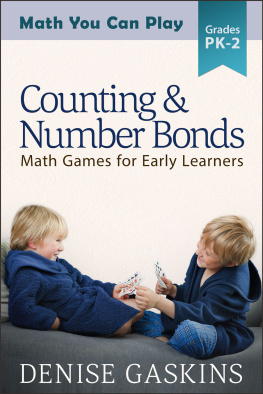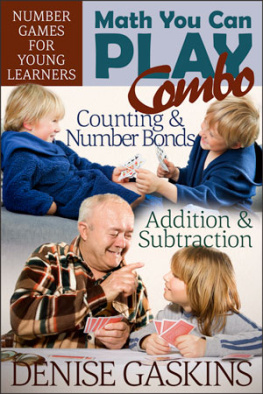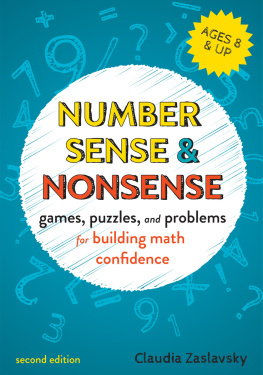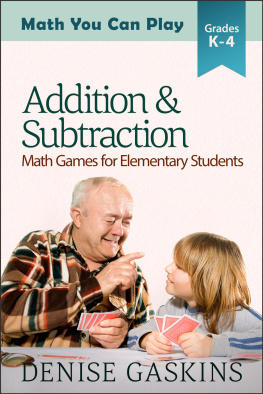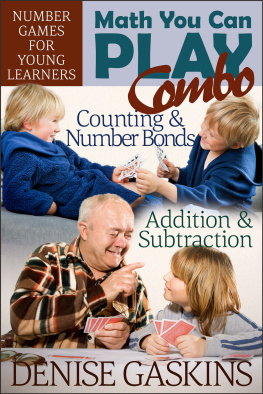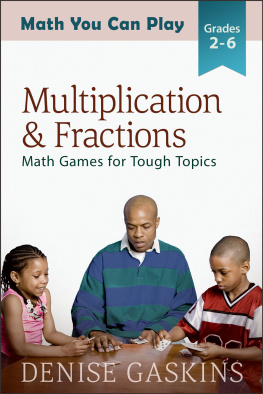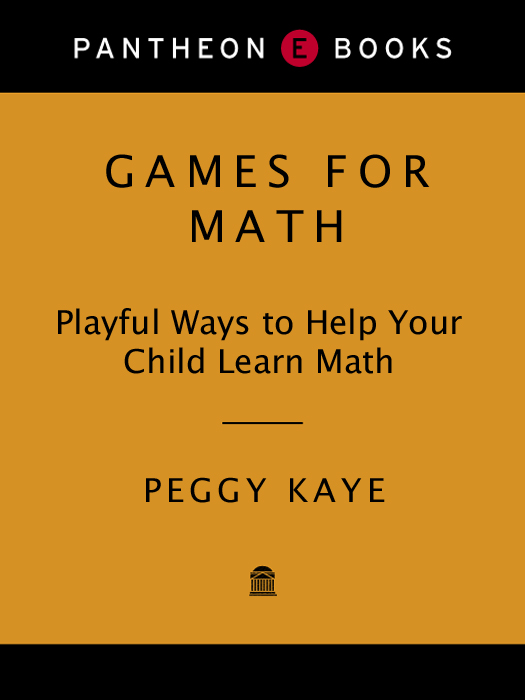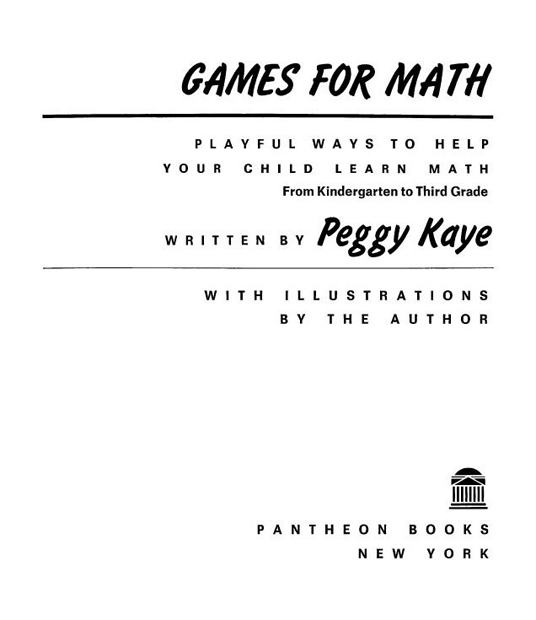Copyright 1987 by Peggy Kaye
All rights reserved under International and Pan-American Copyright Conventions. Published in the United States by Pantheon Books, a division of Random House, Inc., New York, and simultaneously in Canada by Random House of Canada Limited, Toronto.
Library of Congress Cataloging-in-Publication Data Kaye, Peggy, 1948
Games for math.
1. Games in mathematics education. 2. Mathematics Study and teaching (Elementary) I. Title.
QA20.G35K39 1987 510.7 87-45221
eISBN: 978-0-307-80934-6
Book design by Naomi Osnos.
v3.1
ACKNOWLEDGMENTS
My best math teachers have been children. From James, age seven, I learned that children will love mathif they understand what theyre doing. From Josh, age eight, I learned that when children make a spectacular mistake, there is usually a perfectly logical explanation. Nuj, who was seven and spoke Thai better than English, taught me that numbers know no language. Nina, age eight, taught me that when children understand the big ideas, the little ideas will take care of themselves. In teaching, theres no substitute for experience. I hope some of mine comes through to you in the pages that follow.
I am indebted to adults, also. To the teachers of New York City who helped me so muchBarbara Ridge and Gillian Ednie of the Walden School; Bernadette OBrien, Paula Colon, Renee Lustig, Carlo Mitton, Sara Gay Klebanoff, and Donna Lynn Werner of P.S. 9; and Pedro Cordero, Shirley Maynard, and Gene Crichlow of St. Matthews and St. Timothys Daycare Center, all of whom allowed me into their classrooms to conduct experiments and make observationsmany thanks. To Jerome Kaplan, whose expertise and patience were invaluable; to my excellent editor Sara Bershtel and her colleagues David Sternbach, Edward Cohen, David Frederickson, and Jennifer Dossin; to Marilyn Burns, Herbert Kohl, Allan Shedlin, Jr., Christine Stansell, and Sean Wilentz for the advice they gave; to Elizabeth Kaye, chef, and especially to Paul Berman, who magically fixed up sentences, paragraphs, in fact the whole bookthanks!
To my grandfather Joseph A. Daroff
1899-1987
INTRODUCTION
Play Games, by All Means
Every child is different when it comes to math. One child loves big numbers. Another child loves addition. A third sinks into despair at the sight of mathematical symbolsuntil suddenly, at age eight, he develops an unexpected math talent. In one way, though, all children are the same: they like math games. Put the right game in front of a child, explain the rules, and that child will eagerly play, happy and alert.
Ive been teaching math to children privately and in classrooms for many years, and Ive found that games are, from a teachers point of view, wonderfully useful. Games put children in exactly the right frame of mind for learning difficult things. Children relax when they playand they concentrate. They dont mind repeating certain facts or procedures over and over, if repetition is part of the game. Children throw themselves into playing games the way they never throw themselves into filling out workbook pages. And games can, if you select the right ones, help children learn almost everything they need to master in elementary math.
Games have another use, too. They offer a way for parents to get involved in their childrens education. Common sense ought to tell us that parent involvement is a good idea; and if common sense doesnt tell us, there is objective evidence that does. One research study shows that when parents spend time every day helping their first-graders in math and reading, the children make significant academic gains. Another study shows that girls who excel in math tend to have parents especially fatherswho encourage them in that direction. But how should parents get involved? What should they do? My answer is: play games. With the right games, parents dont have to know much about math. They dont have to worry about pushing or pressuring their children, and they neednt fear getting in the way of the school curriculum. All that parents have to do is propose a game to their child and start to play, in a spirit not really different from how they already play with their children.
There are fifty-six games in Games for Math. Several of them are well known to teachers. The rest Ive made up over the years. In every case Ive played these games with children from kindergarten to third grade, and have seen how effective they are. The games solidify the achievements of children who are already good at math, and they shore up children who need shoring up. They teach or reinforce many of the skills that a formal curriculum teaches, plus one skill that formal teaching sometimes leaves out the skill of having fun with math, of thinking hard and enjoying it. If you play these games and your child learns only that hard mental effort can be fun, you will have taught something invaluable.
Learning Math
Children have to learn an immense amount between kindergarten and third grade. They must learn to count, add, subtract, multiply, and divide. They must also learn about sizes and shapes, how to reason logically, how to work in systematic ways when solving problems, how to observe and analyze mathematical patterns, how to appreciate the beautiful designs of our number system. What a task!
To show how they accomplish all this, I will describe Julie, a perfectly ordinary child. Julie entered kindergarten already knowing something about numbers. She could recite from one to fourteen and was happy to demonstrate her ability anytime, anywhere. She was eager to count higher, and by the time kindergarten was over, she could rattle off the numbers from one to one hundred. Julies mastery, though, was not what adults may suppose. Often she made mistakes. She tried to count eight pennies, for instance, and came up with a total of ten. This was because she touched a penny for every number she recited, except that one time she forgot to touch a penny, and at the end she touched a penny that had already been counted, which left her with ten for an answer. Her mistakes were typical of young children. Counting more than five or six objects is harder than you think. And like most children, Julie was not really upset at her error. Thats because young children see numbers in a different light than adults do.
One day I placed two rows of five pennies each in front of Julie:
I told her that one row of pennies belonged to her and the other row belonged to me. Then I asked, Who has more penniesyou or me? Or do we both have the same amount?
Julie answered, We have the same.
I stretched out her pennies and left mine in place:
Again I asked, Who has moreyou or me? Or do we both have the same?
Julie answered, Now I have more.
I asked her to count her pennies. There were five. I asked her to count my pennies. There were five. Nevertheless she still believed she had more. Then I added a penny to my row:


